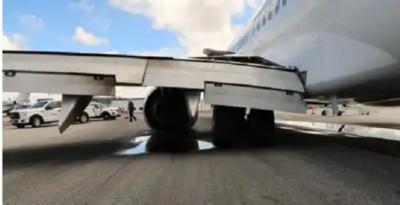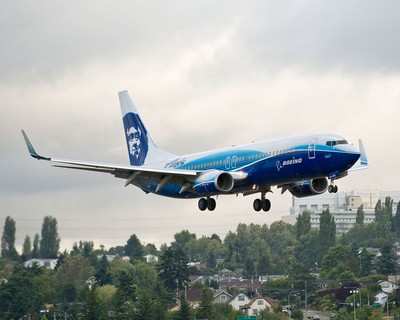What’s Broken Leans Left
The NTSB has released its preliminary report on a 20 August 2023 incident in which a Boeing 737-890, registration N516AS, then acting as Alaska Airlines Flight 1288 sustained serious damage when its left main landing-gear collapsed after an otherwise normal landing on Runway 20R at Santa Ana, California’s John Wayne-Orange County Airport (SNA).

The 112 passengers and crew aboard the aircraft were evacuated to an SNA taxiway via mobile stairs. No injuries were reported.
The incident-flight was operated under Part 121 of the Federal Aviation Regulations as a scheduled domestic passenger flight from Seattle-Tacoma International Airport (SEA) to SNA.
The flight-crew by which Alaska Airlines Flight 1288 was operated reported the aircraft, prior to crossing the SNA Runway 20R final approach fix, had been fully-configured for landing in accordance with the air-carrier’s FAA-approved 737-890 checklist.
Instrument Meteorological Conditions (IMC) comprising moderate rains, variable winds, and light turbulence prevailed in the vicinity of SNA at the time of Flight 1288’s arrival. Though weather conditions were improving, the Pilot In Command (PIC/Captain) and Second In Command (SIC/First Officer) determined a firm touchdown was appropriate under the circumstances. As the SNA tower was closed, the flight-crew had made position reports via the airport’s Common Traffic Advisory Frequency (CTAF).
Flight 1288’s PIC, then the Pilot Flying (PF), established visual contact with the SNA Runway 20R landing environment as the aircraft descended through eight-hundred-feet AGL. In preparation for landing, the PIC took manual control of the jet, disengaging the 737’s autopilot and auto-throttle.
Throughout the approach, the SIC, then Pilot Monitoring (PM), noted the aircraft was maintaining the calculated reference speed (Vref) as well as the appropriate lateral and vertical courses to the touchdown-zone. During the descent, all aircraft systems were observed to be operational, and the entirety of the jet’s landing gear position indicator lights were confirmed green—thereby denoting the aircraft’s Main Landing Gear (MLG) and Nose Gear (NG) assemblies were in their respective down-and-locked positions.
The incident-aircraft crossed the threshold of SNA Runway 20R on glide-path, touching down just beyond the one-thousand-foot marker at approximately 23:15 PDT.
According to flight 1288’s PIC, the touchdown had a “firm jolt feeling,” and the aircraft immediately began pulling “reasonably hard” to the left. The PIC was able to overcome the uncommanded turning moment with opposite (right) rudder-pedal input and managed to keep the aircraft on the runway centerline as it slowed. The PIC advised the SIC the aircraft felt as if one, if not both, tires on the left MLG had gone flat. The SIC completed the appropriate after-landing procedures, which included bringing the 737’s Auxiliary Power Unit (APU) online. The PIC slowed the aircraft to taxi-speed and exited SNA Runway 20R at taxiway “E.”

The flight-crew realized as the PIC negotiated the turn onto the taxiway that the airplane was listing to the left.
The PIC brought the aircraft to a stop on the taxiway, set the parking-brake, opened the sliding L2 window, looked outside, and observed the aircraft to be resting on the left-engine cowling. Immediately, the PIC shut down and secured the left engine, noting as he did so that the left landing gear position indicator light no longer shone green, but had gone completely dark. By way of comparison, the 737’s right MLG and nose-gear position indicator lights remained green.
The PIC made apposite announcements to the cabin-crew and passengers.
The SIC announced via the SNA CTAF that the aircraft would remain on taxiway “E” while SNA crash, fire & rescue responded to the incident.
Upon verifying the absence of fuel-leaks and receiving confirmation from the flight-crew that no injuries had been sustained aboard the aircraft, SNA crash, fire & rescue aided in the evacuation of passengers and crew to taxiway “E” via the incident-aircraft’s R1 door.
Post-accident examination of the 737 revealed the left MLG aft trunnion pin had fractured, allowing the aft aspect of the left MLG to be displaced upwards, puncturing numerous composite panels until it protruded out and above the surface of the aircraft’s left wing. The left MLG walking beam protruded similarly above the surface of subject wing. Additionally, the forward section of the left MLG aft trunnion pin was found to be located within the trunnion and held in place by a damaged but intact cross-bolt. The aft section of the pin had separated and was located in the MLG beam spherical bearing.

The left MLG beam sustained damage as a result of the assembly moving out of position and contacting the beam subsequent the failure of the trunnion pin. The left-wing flap transmission drive unit, located within the 737’s left wheel-well, separated from its mounting structure and was found on SNA Runway 20R near the incident-aircraft’s touchdown point.
The 737’s Digital Flight Data Recorder (DFDR) and Cockpit Voice Recorder (CVR) were removed from the airplane and shipped to the NTSB’s Washington D.C. Vehicle Recorder Laboratory. A preliminary review of downloaded DFDR data indicated the incident-aircraft had touched down with a maximum downward vertical acceleration of 1.71G—a value well-below the 2.2G hard-landing threshold established in Chapter Five (Limitations) of the Alaska Airlines Aircraft Maintenance Manual (AMM).
The aforementioned left MLG trunnion pin was removed and forwarded to Seattle, Washington where it was examined by the Structures Group at Boeing’s Equipment Quality Analysis (EQA) laboratory.
The information here presented is preliminary and subject to change. The NTSB’s investigation of the described incident is ongoing.
 Airborne 05.10.24: Icon Auction, Drunk MedEvac Pilot, Bell ALFA
Airborne 05.10.24: Icon Auction, Drunk MedEvac Pilot, Bell ALFA ANN's Daily Aero-Term (05.13.24): ILS PRM Approach
ANN's Daily Aero-Term (05.13.24): ILS PRM Approach ANN's Daily Aero-Linx (05.13.24)
ANN's Daily Aero-Linx (05.13.24) Airborne-NextGen 05.07.24: AI-Piloted F-16, AgEagle, 1st 2 WorldView Sats
Airborne-NextGen 05.07.24: AI-Piloted F-16, AgEagle, 1st 2 WorldView Sats Airborne 05.08.24: Denali Update, Dad-Daughter Gyro, Lake SAIB
Airborne 05.08.24: Denali Update, Dad-Daughter Gyro, Lake SAIB





